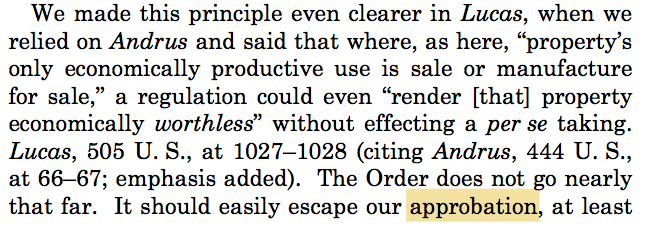Johnson v. U.S. (which I am only now getting a chance to read) finds the “residual” clause of the Armed Career Criminal Act was void for vagueness, and violated the Due Process Clause of the 5th Amendment. Justice Thomas dissented, and argued that the void for vagueness doctrine was akin to substantive due process, and needs to be reconsidered as a matter of original meaning. It is well worth reading.
But buried in a footnote was a citation to his join dissent in NFIB v. Sebelius.
By “penal,” I mean laws “authoriz[ing] criminal punishment” as well as those “authorizing fines or forfeitures . . . [that] are enforced through civil rather than criminal process.” Cf. C. Nelson, Statutory Interpreta- tion 108 (2011) (discussing definition of “penal” for purposes of rule of lenity). A law requiring termination of employment from public insti- tutions, for instance, is not penal. See Keyishian, 385 U. S., at 597– 604. Nor is a law creating an “obligation to pay taxes.” Milwaukee County v. M. E. White Co., 296 U. S. 268, 271 (1935). Conversely, a law imposing a monetary exaction as a punishment for noncompliance with a regulatory mandate is penal. See National Federation of Independent Business v. Sebelius, 567 U. S. ___, ___–___ (2012) (SCALIA, KENNEDY, THOMAS, and ALITO, JJ., dissenting) (slip op., at 16–26).
The Chief cited the joint dissent in King v. Burwell as well, in case you missed that too:
It is implausible that Congress meant the Act to operate in this manner. See National Federation of Independent Business v. Sebelius, 567 U. S. ___, ___ (2012) (SCALIA, KENNEDY, THOMAS, and ALITO, JJ., dissenting) (slip op., at 60) (“Without the federal subsidies . . . the exchanges would not operate as Congress intended and may not operate at all.”).
In any event, Thomas views the void for vagueness doctrine as a species of substantive due process, which he abjured in McDonald v. Chicago.
That we have repeatedly used a doctrine to invalidate laws does not make it legitimate. Cf., e.g., Dred Scott v. Sandford, 19 How. 393, 450–452 (1857) (stating that an Act of Congress prohibiting slavery in certain Federal Territories violated the substantive due process rights of slaveowners and was therefore void). This Court has a history of wielding doctrines purportedly rooted in “due process of law” to achieve its own policy goals, substantive due process being the poster child. See McDonald v. Chicago, 561 U. S. 742, 811 (2010) (THOMAS, J., concurring in part and concurring in judgment) (“The one theme that links the Court’s substantive due process precedents together is their lack of a guiding principle to distinguish ‘fundamental’ rights that warrant protection from nonfun- damental rights that do not”). Although our vagueness doctrine is distinct from substantive due process, their histories have disquieting parallels.
In what also may be a first, Justice Thomas notes that the first draft in Roe was premised on a vagueness, not privacy rationale:
In more recent times, the Court’s substantive due pro- cess jurisprudence has focused on abortions, and our vagueness doctrine has played a correspondingly signifi- cant role. In fact, our vagueness doctrine served as the basis for the first draft of the majority opinion in Roe v. Wade, 410 U. S. 113 (1973), on the theory that laws pro- hibiting all abortions save for those done “for the purpose of saving the life of the mother” forced abortionists to guess when this exception would apply on penalty of con- viction. See B. Schwartz, The Unpublished Opinions of the Burger Court 116–118 (1988) (reprinting first draft of Roe). Roe, of course, turned out as a substantive due process opinion. See 410 U. S., at 164.


